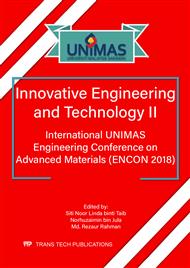[1]
M.M. Bello, A.A. Abdul Rahman, Trend and current practices of palm oil mill effluent polishing: Application of advanced oxidation processes and their future perspectives, J. Environ. Manage. 198 (2017) 170–182.
DOI: 10.1016/j.jenvman.2017.04.050
Google Scholar
[2]
M. Nasrullah, L. Singh, Z. Mohamad, S. Norsita, S. Krishnan, N. Wahida, A.W. Zularisam, Treatment of palm oil mill effluent by electrocoagulation with presence of hydrogen peroxide as oxidizing agent and polialuminum chloride as coagulant-aid, Water Resour. Ind. 17 (2017) 7–10.
DOI: 10.1016/j.wri.2016.11.001
Google Scholar
[3]
C.H. Neoh, A. Yahya, R. Adnan, Z. Abdul Majid, Z. Ibrahim, Optimization of decolorization of palm oil mill effluent (POME) by growing cultures of Aspergillus fumigatus using response surface methodology, Environ. Sci. Pollut. Res. 20(5) (2013) 2912–2923.
DOI: 10.1007/s11356-012-1193-5
Google Scholar
[4]
M.J. Chin, P.E. Poh, B.T. Tey, E.S. Chan, K.L. Chin, Biogas from palm oil mill effluent (POME): Opportunities and challenges from Malaysia's perspective, Renew. Sust. Energ. Rev. 26 (2013) 717–726.
DOI: 10.1016/j.rser.2013.06.008
Google Scholar
[5]
R.R. Mohammed, M.F. Chong, Treatment and decolorization of biologically treated palm oil mill effluent (POME) using banana peel as novel biosorbent, J. Environ. Manage. 132 (2014) 237–249.
DOI: 10.1016/j.jenvman.2013.11.031
Google Scholar
[6]
A.S. Naje, S. Chelliapan, Z. Zakaria, S.A. Abbas, Treatment performance of textile wastewater using electrocoagulation (EC) process under combined electrical connection of electrodes, Int. J. Electrochem. Sci. 10(7) (2015) 5924–5941.
Google Scholar
[7]
A.S. Naje, S. Chelliapan, Z. Zakaria, S.A. Abbas, Electrocoagulation using a rotated anode: A novel reactor design for textile wastewater treatment, J. Environ. Manage. 176 (2016) 34–44.
DOI: 10.1016/j.jenvman.2016.03.034
Google Scholar
[8]
N.F. Jalani, A.A. Aziz, N.A. Wahab, W.H. Hassan, N.H. Zainal, Application of palm kernel shell activated carbon for the removal of pollutant and color in palm oil mill effluent treatment, J. Earth Environ. Health Sci. 2(1) (2016) 15–20.
DOI: 10.4103/2423-7752.181802
Google Scholar
[9]
E. Bazrafshan, M.R. Alipour, A.H. Mahvi, Textile wastewater treatment by application of combined chemical coagulation, electrocoagulation, and adsorption processes, Desalin. Water Treat. 57(20) (2016) 9203–9215.
DOI: 10.1080/19443994.2015.1027960
Google Scholar
[10]
A. Aouni, R. Lafi, A. Hafiane, Feasibility evaluation of combined electrocoagulation/adsorption process by optimizing operating parameters removal for textile wastewater treatment, Desalin. Water Treat. 60 (2017) 78–87.
DOI: 10.5004/dwt.2017.10890
Google Scholar
[11]
Y. Ait Ouaissa, M. Chabani, A. Amrane, A. Bensmaili, Integration of electro coagulation and adsorption for the treatment of tannery wastewater - The case of an Algerian factory, Rouiba, Procedia Eng. 33 (2012) 98–101.
DOI: 10.1016/j.proeng.2012.01.1181
Google Scholar
[12]
D.T. Moussa, M.H. El-Naas, M. Nasser, M.J. Al-Marri, A comprehensive review of electrocoagulation for water treatment: Potentials and challenges, J. Environ. Manage. 186 (2017) 24–41.
DOI: 10.1016/j.jenvman.2016.10.032
Google Scholar
[13]
O. Sahu, B. Mazumdar, P.K. Chaudhari, Treatment of wastewater by electrocoagulation: A review, Environ. Sci. Pollut. Res. 21(4) (2014) 2397–2413.
DOI: 10.1007/s11356-013-2208-6
Google Scholar
[14]
O.S. Bello, M.A. Ahmad, Coconut (cocos nucifera) shell based activated carbon for the removal of malachite green dye from aqueous solutions, Sep. Sci. Technol. 47(6) (2012) 903–912.
DOI: 10.1080/01496395.2011.630335
Google Scholar
[15]
D. Das, D.P. Samal, M. Bc, Preparation of activated carbon from green coconut shell and its characterization, Chem. Eng. Process Technol. 6(5) (2015) 1–7.
DOI: 10.4172/2157-7048.1000248
Google Scholar
[16]
A.F. Rugayah, A.A. Astimar, N. Norzita, Preparation and characterisation of activated carbon from palm kernel shell by physical activation with steam, J. Oil Palm Res. 26(3) (2014) 251–264.
Google Scholar
[17]
K. Yang, J. Peng, C. Srinivasakannan, L. Zhang, H. Xia, X. Duan, Preparation of high surface area activated carbon from coconut shells using microwave heating, Bioresour. Technol. 101 (2010) 6163–6169.
DOI: 10.1016/j.biortech.2010.03.001
Google Scholar
[18]
A.R. Hidayu, N. Muda, Preparation and characterization of impregnated activated carbon from palm kernel shell and coconut shell for CO2 capture, Procedia Eng. 148 (2016) 106–113.
DOI: 10.1016/j.proeng.2016.06.463
Google Scholar
[19]
A.R. Hidayu, N.F. Mohamad, S. Matali, A.S.A.K. Sharifah, Characterization of activated carbon prepared from oil palm empty fruit bunch using BET and FT-IR techniques, Procedia Eng. 68 (2013) 379–384.
DOI: 10.1016/j.proeng.2013.12.195
Google Scholar
[20]
A.R. Yacob, Z. Abdul Majid, R.S.D. Dasril, V. Inderan, Comparison of various sources of high surface area carbon prepared by different types of activation, MJAS 12(1) (2008) 264–271.
Google Scholar
[21]
C.G. Joseph, S.M. Anisuzzaman, S. Abang, B. Musta, K.S. Quek, X.L. Wong, Adsorption performance and evaluation of activated carbon from coconut shell for the removal of chlorinated phenols in aqueous medium, Mater. Sci-Medzg 23(4) (2017) 389–397.
DOI: 10.5755/j01.ms.23.4.16221
Google Scholar
[22]
S. Mhatre, V. Vivacqua, M. Ghadiri, A.M. Abdullah, M.J. Al-Marri, A. Hassanpour, B. Hewakandamby, B. Azzopardi, B. Kermani, Electrostatic phase separation: A review, Chem. Eng. Res. Des. 96 (2015) 177–195.
DOI: 10.1016/j.cherd.2015.02.012
Google Scholar
[23]
H. Rubí-Juárez, C. Barrera-Díaz, F. Ureña-Nuñez, Adsorption-assisted electrocoagulation of real car wash wastewater with equilibrium and kinetic studies, Pollut. Res. 36(2) (2017) 175–184.
Google Scholar
[24]
J. Gao, D. Kong, Y. Wang, J. Wu, S. Sun, P. Xu, Production of mesoporous activated carbon from tea fruit peel residues and its evaluation of methylene blue removal from aqueous solutions, BioResources 8(2) (2013) 2145–2160.
DOI: 10.15376/biores.8.2.2145-2160
Google Scholar
[25]
R.R. Mohammed, Decolorisation of biologically treated palm oil mill effluent (POME) using adsorption technique, IRJES 2(10) (2013) 1–11.
Google Scholar


